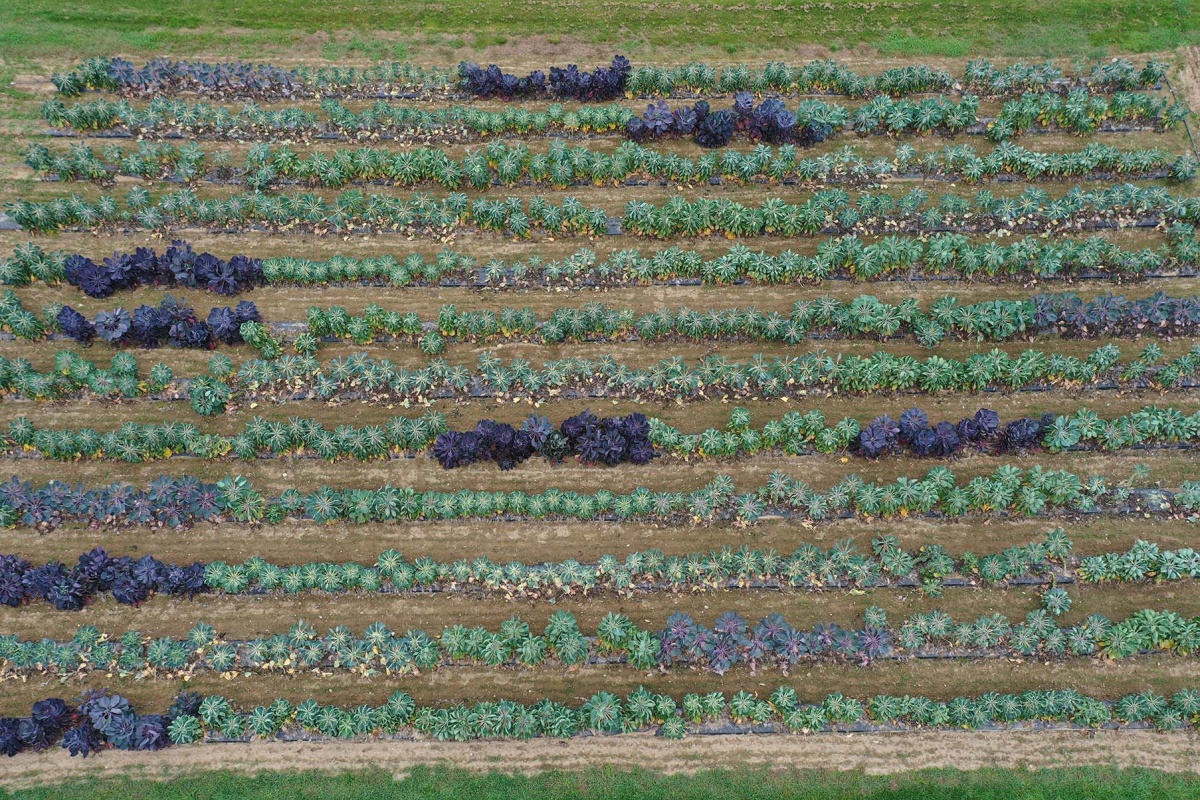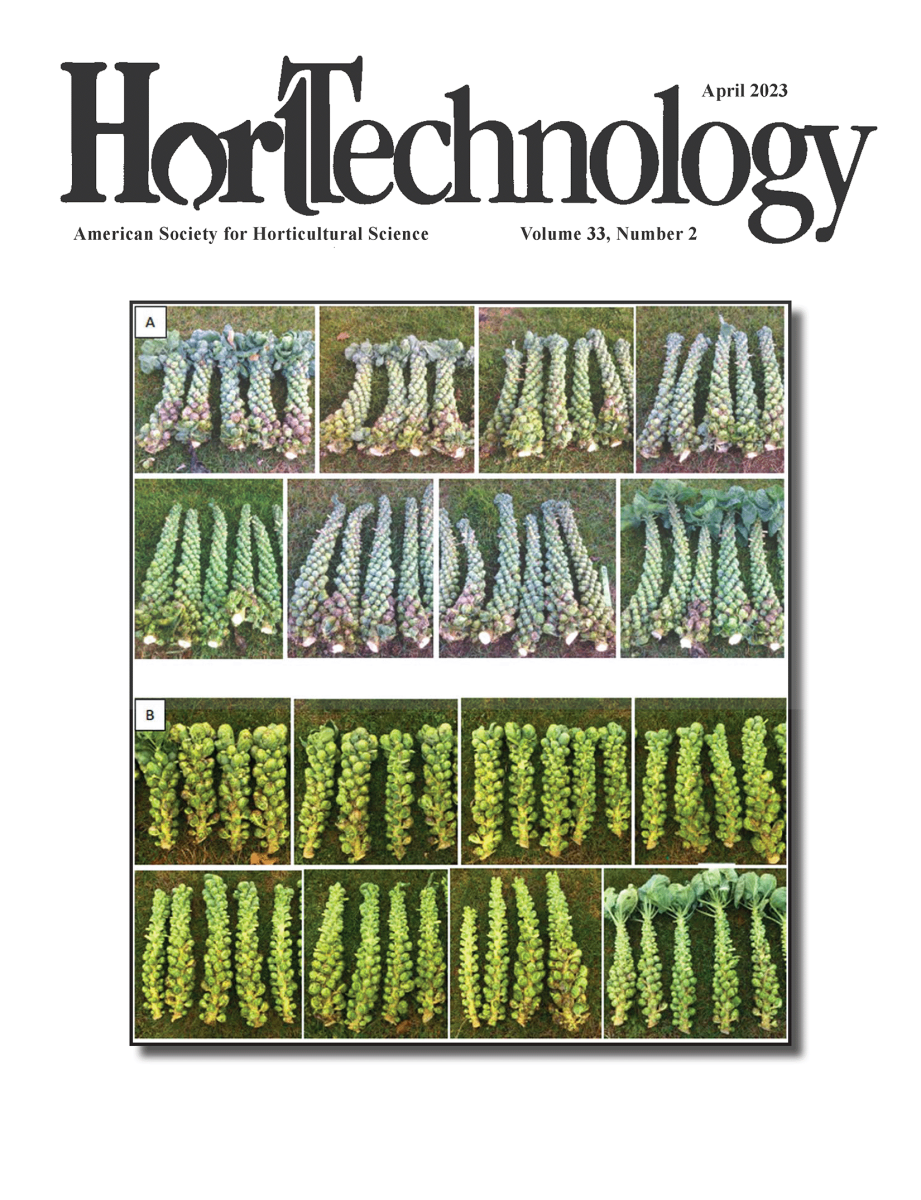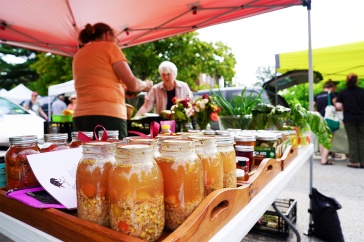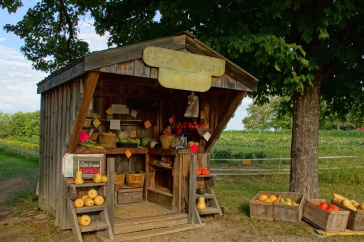Photos of Brussels sprout plants (Jade E Cross and Diablo varieties) topped at different dates
(A): Shown, arranged from left to right and top to bottom, are ‘Jade Cross E’ plants grown in 2015, topped on 24 Aug, 4 Sep, 11 Sep, 17 Sep, 24 Sep, 2 Oct, and 23 Oct; and untopped plants. (B): Shown, arranged from left to right and top to bottom, are ‘Diablo’ plants grown in 2017 topped on 29 Aug, 4 Sep, 11 Sep, 18 Sep, 26 Sep, 3 Oct, and 11 Oct; and untopped plants. Photos were taken on 15 Nov 2015 (A) and 16 Nov 2017 (B).
Key Finding:
Certain Brussels sprout cultivars produced higher yields with fewer disease symptoms than others, and early and midseason cultivars showed increased yields in response to topping—except when topping was performed too early. The ideal topping date varied for each cultivar and ranged from early to late September.
Apical meristem: Refers to the new growth occurring at the tips of the plant, either in the roots (root apical meristem) or shoots (shoot apical meristem).
Brassicas: Genus of plants that include the cabbage and mustard family and referred to informally as cruciferous vegetables. This includes Brussels sprout, cauliflower, cabbage, broccoli, as well as some leafy vegetables like kale, spinach and garden cress.
Marketable yield: Amount of sellable fruit produced by a crop.
“Topping”: Process of trimming the shoot apical meristem from a plant, with the goal of producing fuller, bushier growth.
Spring gardening in the Northeast relies on cool-weather crops—those that thrive in cooler temperatures (70 degrees or below), can be planted when soil and air temperatures reach 40 degrees Fahrenheit, and can survive light frosts. And this categorization certainly reflects the crops grown in the region, especially those in the brassica genus. For example, in 2017, Granite State farmers produced close to 150,000 pounds of broccoli, upwards of 300,000 pounds of cabbage heads, more than 287,000 pounds of cauliflower and 220,500 pounds of kale—all cold-weather brassica plants. Brussels sprouts, however, are grown sparingly in New Hampshire, hampered partially by pests such as cabbage aphids as well as uncertainty of yields and adaptability across available varieties for commercial and backyard enthusiasts. New research from the New Hampshire Agricultural Experiment Station (NHAES) is helping northern New England growers develop best management practices to overcome these challenges.
Brussels: A Quintessential Fall & Early Winter Vegetable
Brussels sprouts (Brassica oleracea var. gemmifera) are usually sown indoors in mid-May in New England before they are transplanted outdoors in late May or mid-June. Requiring about three or more months of grow time in the ground, they should be ready for harvest by September through November. A newly published study—led by NHAES researcher Becky Sideman—examined the benefits of removing new growth occurring at the tips of the plants in the shoot apical meristem, or “topping,” on 23 different Brussels sprout cultivars grown in the Northeast. The research, which took place over the growing seasons of 2013–2015 and 2017, examined early and mid-season cultivars and assessed yield and sprout size of topped and un-topped plants.
“Brussels sprout is a quintessential fall and early winter vegetable that can easily be grown in New England,” said Sideman, professor of horticulture at the UNH College of Life Sciences and Agriculture. “Worldwide, however, Brussels sprout is mostly grown commercial in areas with cool mild climates, such as California and the Pacific Northwest, and in the United Kingdom and the Netherlands.”
“As a result, many varieties are adapted to extremely long and mild growing seasons, and because varieties often perform differently from one another, it’s important to evaluate modern varieties in this region to identify those that perform well in our climate,” she added.
Harvesting Brussels: Timing is Critical
When harvesting Brussels sprouts in the Northeast, timing is critical. Harvesting after a frost reduces the sprouts’ bitterness but freeze damage can occur if plants are exposed to temperatures less than 14 F, resulting in a narrow harvest window for growers in cooler climates. Furthermore, the selection of cultivars and the planting date can both impact total yield, bud (or sprout) enlargement and the optimal harvest date. Alternaria blight, caused by Alternaria sp., also limits production of Brussels sprout in this region of the country, however disease severity is greatly affected by environmental conditions and varies by season.
“For those growing Brussels sprouts, topping them in mid-September is an easy practice that is likely to help increase the number of quality sprouts you harvest. Plus, with this study, we were able to identify varieties that are likely to do well in our region—helping farmers and gardeners produce high quality crops.”
“In recent years especially, high populations of the invasive cabbage aphid (Brevicoryne brassicae) have also limited production of Brussels sprout in the Northeast,” said Sideman. “And unfortunately, in this study we didn’t see much difference in certain varieties being less susceptible to the cabbage aphid.”
Cover image of HortTechnology, featuring research by NHAES scientists Becky Sideman, Caterina Roman and Elisabeth Hodgdon.
Topping Brussels to Increase Yield
Topping is a common practice to increase yield of Brussels sprout, but it must occur at the right time. Early removal causes terminal buds (i.e., the sprouts) to bolt and limits the length of the harvested stalk. Building upon earlier work in this field, the scientists found that topping can increase marketable yield and the uniformity of stalk growth in Brussels sprouts while decreasing the proportion of under- or oversized sprouts. Early and midseason cultivars showed increased yields in response to topping, but topping did not affect yields for cultivars with sprouts that did not reach marketable size within the growing season. The ideal topping date window varied slightly for each cultivar and ranged from early to late September.
“For those growing Brussels sprouts, topping them in mid-September is an easy practice that is likely to help increase the number of quality sprouts you harvest,” said Sideman. “Plus, with this study, we were able to identify varieties that are likely to do well in our region—helping farmers and gardeners produce high quality crops.”
This material is based on work supported by the NH Agricultural Experiment Station through joint funding from the USDA National Institute of Food and Agriculture (under Hatch award number 1019868) and the state of New Hampshire. Funding also came from the New Hampshire Vegetable and Berry Growers Association and from the Northeast Sustainable Agriculture Research and Education (SARE) Project LNE 18-365.
This work is co-authored by Rebecca Sideman, Caterina Roman ’22 and Elisabeth Hodgdon ’13G.
Read Brussels Sprout Cultivar Performance and Response to Apical Meristem Removal, in HortTechnology, where the research was featured on the front-page of the Volume 33 (2023): Issue 2 (April 2023).
-
Written By:
Nicholas Gosling '06 | COLSA/NH Agricultural Experiment Station | nicholas.gosling@unh.edu























































